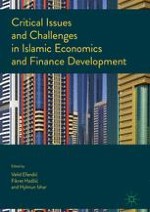2017 | OriginalPaper | Chapter
4. A Look at Cash Waqfs as Islamic Financial Institutions and Instruments
Authors : Mehmet Bulut, Cem Korkut
Published in: Critical Issues and Challenges in Islamic Economics and Finance Development
Publisher: Springer International Publishing
Activate our intelligent search to find suitable subject content or patents.
Select sections of text to find matching patents with Artificial Intelligence. powered by
Select sections of text to find additional relevant content using AI-assisted search. powered by
